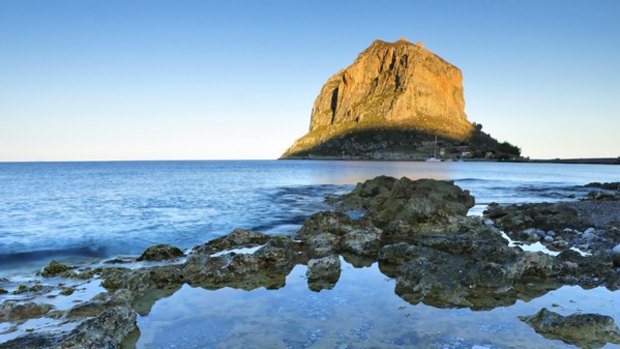
Medieval magic ... Monemvasia rises out of the sea.Credit: iStock
Size isn't everything, as the saying goes. World Heritage-listed Monemvasia, in the southern Peloponnese, is proof of that. Greece's answer to the Iberian Peninsula's Rock of Gibraltar or France's Mont Saint Michel, this tiny place delivers big delights. Perched off the coast, Monemvasia is an extraordinary hunk of rock, whose massive cliffs plunge into the sea. Nestled at its base but obscured from view is a medieval village known by locals as the Kastro (fortress). On the rock's upper slopes are the sprawling ruins of an ancient fortress. A narrow causeway joins the rock to the mainland at the small, modern village of Gefyra. For the record (because few people know it), modern-day Monemvasia also incorporates Gefyra and surrounding villages. But most visitors are lured by the incredible Kastro. And it's easy to see why.
There are no cars in the Kastro - it's walking only - and entrance is through an L-shaped tunnel. My arrival at the tunnel door coincides with a bridal procession. True to Greek style, a wedding can include the village's entire population, which accompanies the bride through the streets to the church. I find myself swept along with the throng of guests, almost suffocating in the haze of bright-pink tulle, large cleavages, perspiring bodies and enthusiastic singing guests. It's a real-life scene straight out of the film My Big Fat Greek Wedding.
We wobble along the village's main lane; the uneven cobblestones are especially challenging for stiletto-wearing guests. I glimpse medieval buildings that house upmarket tourist shops, converted hotels and the town's three tavernas. A few minutes later, we spill into a tiny town square where a church - Christos Elkomenos (Church of Christ in Chains) - has stood since 1000AD. The crowd disperses and I emerge, blinking, like Alice arriving in Wonderland.
I turn around slowly to absorb my magical surroundings: a mass of terracotta roofs, brown brickwork, Byzantine domes, a Turkish bath, a fortress wall. History embraces me. Little seems to have changed since Byzantine times, when the town was in its prime.
Founded in about 550 AD, Monemvasia survived marauding groups of Arabs and Normans. Jump forward to the 10th century onwards and the town became an extremely important and wealthy commercial and maritime centre, thanks to its position on the trade route. In its prime, Monemvasia's population is believed to have reached 40,000 to 50,000 people. For the next eight centuries, the Venetians and Ottomans squabbled over it until Greece's eventual independence in 1821.
After World War II, residents left en masse - poverty was rife and there was little to sustain them. These days, only seven people live here permanently but numbers swell on weekends and in summer, thanks to returning locals and foreign visitors.
Monemvasia is renowned for more than its rock. Greece's famous left-wing poet, Yiannis Ritsos, was born here. For centuries, the region has produced Malmsey wine, the very beverage in which the Duke of Clarence is drowned in Shakespeare's Richard III.
My delightful Swiss host, Isabelle, reveals hidden Monemvasia. Together, like mice in a maze, we explore the Kastro's alleyways, arches, ruins and fortress walls. Many of the buildings are now hotels, guesthouses and private residences, tastefully converted, dripping with bougainvillea and well-tended geraniums.
We leave the fortress and climb to the ancient town on the upper slopes to one of few surviving buildings, a Byzantine chapel (it's locked).
A 360-degree view of the mainland and ocean is astounding. Back down in the Kastro, Isabelle shows me her secret way to the Portello, an ancient door leading on to the rocks and ocean. We strip off and swim and take delight in viewing the rock from a different perspective.
On the way home, I'm welcomed into the home of seventysomething resident Constantina, who returned to Monemvasia several years ago and has turned her home and nearby buildings into a B&B. Of her return, she says: "I was born here." She points to the wooden framed couch in her cramped cottage. "I know the life here. I make my living out of it and I have friends," she states adamantly.
It's a sentiment shared with Marianthi, an elderly retired sea captain who has travelled the world for decades. We pass him in a narrow alley. He is sitting on a stool outside his birth home peeling fresh apricots. He returns here each summer. "Why?" I ask. I don't need to. "That's easy! First of all, I was born here. Second, I have friends here. Returning gives me big joy." Size indeed.
The writer travelled with the assistance of Emirates and was a guest of Monopati Rooms and Apartments.
GETTING THERE
Emirates flies daily to Athens via Dubai.
WHERE TO STAY
Monopati Rooms & Apartments, €70 ($110) to €160, phone +30 27320 61772, see byzantine-escapade.com.
Malvasia Hotel, doubles from €80-€120, includes breakfast, phone +30 27320 63007, see en.malvasia-hotel.gr.
WHERE TO EAT
Matoula, phone +30 27320 61660; Marianthi, phone +30 27320 61371 ; To Kanoni, phone +30 27320 61387. You can't go wrong with any of the three options: Matoula has the best view, Marianthi has the best food and To Kanoni the best service.
Sign up for the Traveller Deals newsletter
Get exclusive travel deals delivered straight to your inbox. Sign up now.